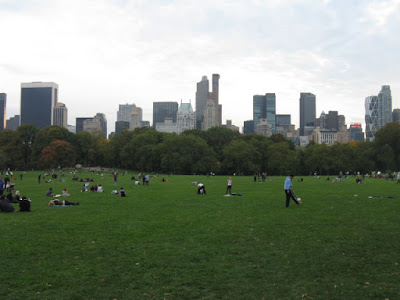... AND A MISADVENTURE
(About yesterday's entry: that was supposed to be tongue-in-cheek, light-hearted, not a serious gripe. At least one reader read it otherwise, which must have made me seem very mean-spirited. Apologies!)
As I was saying, we woke to a glorious Sunday morning in New York City, discovering for the first time our view out over Central Park, where the leaves are only just beginning to turn--rather later than usual this year...

In a week or so, they should be in full splendor. We had no plan, but for a walk in the park... and a theater date in the evening.
But first, that misadventure. We have a new Whole Foods market just around the corner from where we are staying, on Columbus Circle, and our first venture into the city was to buy a copy of the New York Sunday Times and provide ourselves with some of the basics, tea and coffee and breakfast cereal and eggs. A fantastic market, occupying a vast space below the new(ish) Time Warner Center...
Well, we found what we needed and returned to our apartment loaded with shopping bags. Unlocked the door into the apartment from the long corridor, and left the key--for a moment, I intended--in the lock while I took the bags into the kitchen. Door swung closed automatically behind us, and I promptly forgot about the keys. A moment of inattention only... We enjoyed our breakfast and got ready to head out around noon; felt in pocket for key... and remembered, suddenly where I'd left them.
A moment of panic. Checked the door. No keys. Searched pockets, bags, apartment. No keys. Someone, surely, had turned them in at the front desk, downstairs. I took the elevator down. Nothing. no keys. If someone had noticed them, I reasoned, without ringing at our doorbell to let us know--and without turning them in at the front desk--they could have no good intentions. We'd have to get the lock changed to our friend's apartment.
Enter Richie, the handyman for this huge apartment building. Within minutes, literally, he appeared at our door with a new core and had it installed, at relatively minor cost. Our hero. Then came the embarrassing task of letting our kind friend know about my mindlessness, and that he now had a new set of keys to his apartment waiting for him at the desk. A flurry of calls and emails, (I discover that my I-Phone is not working) none of them returned. I'm left with my embarrassment and discomfort as we finally leave for our walk in the park. Ellie is kind enough to remind me, with exquisite cruelty, that this is a fine moment to recall the Buddhist teachings about the importance of mindfulness.
Ah, but the park... such a treat to stroll for miles along its byways. Surprised to find, on our way there, that Broadway had turned into one huge street fair for the day. Quite a scene!

We found Central Park bustling with activity, buskers...

... and skateboarders...

... and lovers...
... and tots in the playgrounds and ancient couples sitting hand in hand on the benches everywhere.

What a pleasure to walk and walk aimlessly, and to be in touch with every aspect of humanity, people of every nation, race and color, and to overhear snatches of conversation in dozens of different languages. To watch the fountains playing and the rowboats on the lake...


Such a treat. Here's Ellie on the Mall...
We walked for hours, ending up with a very late lunch at Le Pain Quotidiain...

... before heading for home to rest up a bit before our theater date. (Turned out to be not so restful: I spent much of the time with AT&T, trying to resolve the I-Phone problem. With success, I'm happy to report. You can now call me, if you know my number.)
The Richard Rogers theater is located only a dozen blocks from where we're staying, so we walked down the hugely crowded 8th Avenue, expecting first to meet our nephew, Danny, and his fiancee in the lobby. They had recommended the show. Picked up our tickets at will-call and, failing to find them found our seats instead, second row, first balcony, great view of the stage. Had no idea what to expect. "In the Heights" turned out to be a musical about Washington Heights, uptown, a predominantly Latino area bustling with life and a multitude of people living it. Imagine "Our Town" meets "West Side Story" in a contemporary setting. People struggling to get by in a tough economy. Immigrants struggling to find an American identity and keep something of their own. The driver and energy of the performance were extraordinary and the story a compelling and moving one. If I were a theater critic, I might carp about what seemed at times like overdrive--a multiplicity of production numbers that tended to overwhelm some very tender, very emotional moments where we were allowed to get closer to the characters. But I'm not a theater critic.
After the performance, we went backstage to meet a couple of good friends of Rachel's--one of the leading actors in the show, and an engineer and hopeful playwright who works for the theater and gave us a full backstage tour of the working end of the things that happen on the stage, from wardrobe to set design and lighting to sound systems for the actors. Then on for a glass of wine at a bar called Thalia--also the name of the main street off which we live in Laguna Beach. We felt right at home. It was after midnight by the time we got back to the apartment, where we found Harry waiting for us with his customary air of disapproval.











































+YC10.018+lr.jpg)
+YC10.004+lr.jpg)
+YC10.004+detail+lr.jpg)





